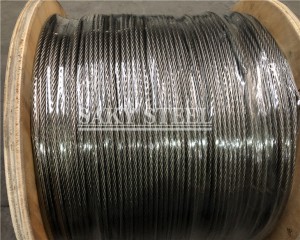Choose the right stainless steel wire rope for your application
To use the stainless steel wire rope economically and safely, the stainless steel wire rope must be correctly selected from the following aspects. The choice of stainless steel wire rope should be considered according to different applications.
Wire rope breaks pull. In the condition of a certain wire rope diameter and tensile strength, a wire rope with a metal density coefficient (ie, the ratio of the wire cross-sectional area to the rope load area) should be selected. In general, the order of the density coefficient of the wire rope is that the surface contact rope is larger than the wire contact rope, and the wire contact rope is greater than the point contact rope.
Fatigue resistance. Under normal circumstances, the surface contact rope is better than the line contact rope, and the line contact rope is better than the point contact rope; the pretensioned rope is better than the non-pretensioned rope; the same structure is better in the same direction than the cross tension; the ratio of the fiber rope core rope is better; Metal core rope is good.
Abrasion resistance. The greater the contact surface between the steel wire rope and the pulley or reel, the smaller the contact stress, the better the wear resistance. Therefore, the order of the wear resistance is the sealing rope, the special-shaped yarn rope, the multi-strand rope, and the round yarn rope. . For external wear resistance, the outer wire diameter is more favorable; for internal wear resistance, wire contact and surface contact are superior to point contact.
Resistance to pressure. Mainly in the ability of the steel wire rope to resist structural deformation when subjected to lateral pressure. The general metal rope core is superior to the fiber rope core, and the stock wire is less than the stock wire. The line contact is better than the point contact, the surface contact is better than the line contact, and the same structure is better than the same direction.
Softness. The greater the number of steel wires at the same rope diameter, the greater the flexibility coefficient (the ratio of the wire rope diameter to the thickest wire diameter in the rope) and the better the flexibility.
Corrosion resistance. Most steel wire ropes are used in atmospheric environments and even acidic or alkaline corrosive media. Practice has proved that choosing galvanized, zinc aluminum alloy, oil seal rust-proof, reducing the moisture content of the core, coating nylon, plastic and other anti-corrosion measures will be exponentially improved. Wire rope service life.
Structural elongation and elastic modulus. When the fixed-length use or rope adjustment is troublesome or difficult, the wire rope with small structural elongation and large elastic modulus should be selected. Under normal circumstances, the elongation of metal rope core wire rope structure is approximately 0.1%-0.2%, and that of fiber rope core wire rope is 0.5%-0.6%. The elongation of the steel wire rope structure processed by pretensioning can be reduced by 0.1%-0.3%, and at the same time can be improved. Elastic Modulus.
Post time: Jun-05-2018
